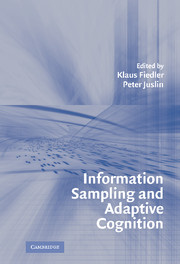Book contents
- Frontmatter
- Contents
- List of Contributors
- PART I INTRODUCTION
- PART II THE PSYCHOLOGICAL LAW OF LARGE NUMBERS
- PART III BIASED AND UNBIASED JUDGMENTS FROM BIASED SAMPLES
- 6 Subjective Validity Judgments as an Index of Sensitivity to Sampling Bias
- 7 An Analysis of Structural Availability Biases, and a Brief Study
- 8 Subjective Confidence and the Sampling of Knowledge
- 9 Contingency Learning and Biased Group Impressions
- 10 Mental Mechanisms: Speculations on Human Causal Learning and Reasoning
- PART IV WHAT INFORMATION CONTENTS ARE SAMPLED?
- PART V VICISSITUDES OF SAMPLING IN THE RESEARCHER'S MIND AND METHOD
- Index
- References
9 - Contingency Learning and Biased Group Impressions
Published online by Cambridge University Press: 02 February 2010
- Frontmatter
- Contents
- List of Contributors
- PART I INTRODUCTION
- PART II THE PSYCHOLOGICAL LAW OF LARGE NUMBERS
- PART III BIASED AND UNBIASED JUDGMENTS FROM BIASED SAMPLES
- 6 Subjective Validity Judgments as an Index of Sensitivity to Sampling Bias
- 7 An Analysis of Structural Availability Biases, and a Brief Study
- 8 Subjective Confidence and the Sampling of Knowledge
- 9 Contingency Learning and Biased Group Impressions
- 10 Mental Mechanisms: Speculations on Human Causal Learning and Reasoning
- PART IV WHAT INFORMATION CONTENTS ARE SAMPLED?
- PART V VICISSITUDES OF SAMPLING IN THE RESEARCHER'S MIND AND METHOD
- Index
- References
Summary
Impression formation about social groups relies on the sampling and integration of group-related information from the environment and from memory. As a consequence, biased group impressions may arise from increased prevalence of certain kinds of social information in the world, from differential retrieval of social information from memory, and from an uncritical use of environmental or stored information in the judgment process of the “naïve intuitive statistician.” The present chapter reframes well-known judgment biases in group impression formation, such as illusory correlations and spurious correlations, as sampling phenomena. In particular, it is argued that group-related probabilistic information is extracted quite accurately from the environment and that unwarranted inferences on the basis of correctly learned proportions and correlations can cause systematic judgment biases. Whereas traditional explanations of biased group impressions focus on distorted retrieval or simplistic representation of the co-occurrence of group membership with positive or negative behaviors, the theoretical perspective of pseudo-contingencies (Fiedler, 2000) implies that erroneous impressions may reflect inferences from true frequency relations and from true covariations in complex social scenarios. The present chapter reviews empirical evidence for the pseudo-contingency account from previous studies on biased group impression formation, and it presents two new experiments that test specific predictions of the novel account. The final section addresses the question of whether pseudo-contingencies merely mirror a metacognitive deficit in inductive inference or whether they result from a rational decision strategy.
Information
- Type
- Chapter
- Information
- Information Sampling and Adaptive Cognition , pp. 183 - 209Publisher: Cambridge University PressPrint publication year: 2005
